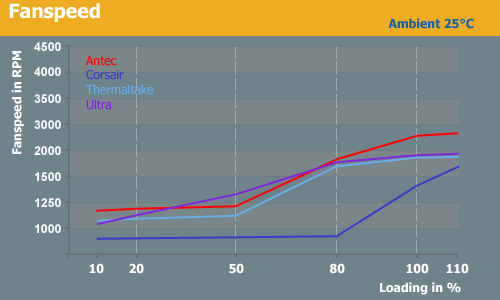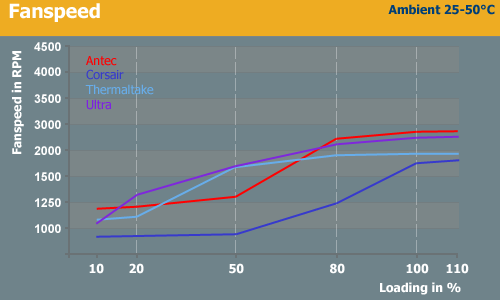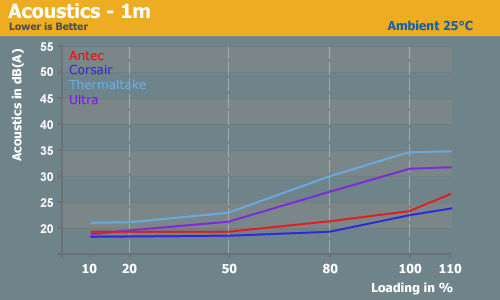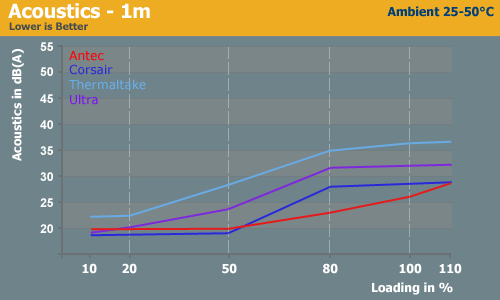400-450W PSU Roundup
by Christoph Katzer on November 6, 2007 4:00 AM EST- Posted in
- Cases/Cooling/PSUs
Comparison
With the four power supplies tested today, we can get a basic idea about the products in the market. Unfortunately, this is a market where higher quality power supplies are getting rare since 500W is the lower end for most companies. A few good manufacturers make 400W and maybe sometimes 350W models, but with many graphics cards "requiring" 500W and higher power supplies marketing has definitely moved to less reasonable units. Rather than creating a good quality 350W power supply, most manufacturers are more interested in attaching a few more cables, adding a couple more components, and selling a 500W (or higher) power supply.
Seasonic is one of the few companies that continue to cater to this market, so it's not too surprising that in addition to their own brand they are also the production facility for the Earthwatts and Corsair power supplies. Staying with Seasonic, however, the M12II series will come out soon and Seasonic wants to start the series at 500W -- just as they did with the first M12 series. That leaves Maxpoint as one of the only remaining companies looking to continue producing lower wattage models.
Despite the marketing hype, many users really have no need for anything beyond a moderate 400W power supply, and perhaps not even that. Consider our results from the GeForce 8800 GT article: with an upper-midrange system, we still topped out at a whopping 327W -- and that's power draw from the wall, not power supply output! Assuming 80% efficiency for the power supply, that particular test system is only using around 260W of power.
As we have seen today, of course, simply going out and grabbing any old 400W power supply might not be a good idea for such a system. While three of the tested power supplies today perform well, we would be very concerned with the prospect of using something like the Ultra 400W. As usual, you get what you pay for. Unfortunately, it seems as though most of the quality power supplies in this range will disappear over the coming year or two, leaving the lower wattage market to cheaper designs that really underperform.
Before we wrap up, let's take a quick look at how the power supplies stack up in a few meaningful areas. We'll start with fan speeds and acoustics.


Corsair clearly has the lowest fan speeds in comparison to the other units. It stays below 1000 RPM until a load of more than 350W is applied. In most actual computers, it will be nearly silent. The other units start to ramp up fan speeds much earlier, which should be not necessary. Corsair keeps the lead even under higher ambient temperatures, despite the fact that the other three power supply fans are spinning 50% faster. Fan speed doesn't really count for noise levels or fan size, however, so let's look at noise measurements.


Comparing the acoustics is interesting because the Antec shows its potential here. The fan turns slightly faster but still produces less noise. Both the Antec and Corsair have a very low noise level and are practically silent. If you're interested in a low wattage, low noise level PSU, Antec and Corsair are definitely worth a look (as well as Seasonic, naturally). The other two power supplies don't do nearly as well. Thermaltake is even louder than the Ultra unit is, even though the fan spins at lower RPMs. Thermaltake should definitely think about changing the fan -- or maybe redesigning the fan grill, heatsinks, or whatever else is necessary -- to bring performance up to the level of Seasonic, et al.
With the four power supplies tested today, we can get a basic idea about the products in the market. Unfortunately, this is a market where higher quality power supplies are getting rare since 500W is the lower end for most companies. A few good manufacturers make 400W and maybe sometimes 350W models, but with many graphics cards "requiring" 500W and higher power supplies marketing has definitely moved to less reasonable units. Rather than creating a good quality 350W power supply, most manufacturers are more interested in attaching a few more cables, adding a couple more components, and selling a 500W (or higher) power supply.
Seasonic is one of the few companies that continue to cater to this market, so it's not too surprising that in addition to their own brand they are also the production facility for the Earthwatts and Corsair power supplies. Staying with Seasonic, however, the M12II series will come out soon and Seasonic wants to start the series at 500W -- just as they did with the first M12 series. That leaves Maxpoint as one of the only remaining companies looking to continue producing lower wattage models.
Despite the marketing hype, many users really have no need for anything beyond a moderate 400W power supply, and perhaps not even that. Consider our results from the GeForce 8800 GT article: with an upper-midrange system, we still topped out at a whopping 327W -- and that's power draw from the wall, not power supply output! Assuming 80% efficiency for the power supply, that particular test system is only using around 260W of power.
As we have seen today, of course, simply going out and grabbing any old 400W power supply might not be a good idea for such a system. While three of the tested power supplies today perform well, we would be very concerned with the prospect of using something like the Ultra 400W. As usual, you get what you pay for. Unfortunately, it seems as though most of the quality power supplies in this range will disappear over the coming year or two, leaving the lower wattage market to cheaper designs that really underperform.
Before we wrap up, let's take a quick look at how the power supplies stack up in a few meaningful areas. We'll start with fan speeds and acoustics.


Corsair clearly has the lowest fan speeds in comparison to the other units. It stays below 1000 RPM until a load of more than 350W is applied. In most actual computers, it will be nearly silent. The other units start to ramp up fan speeds much earlier, which should be not necessary. Corsair keeps the lead even under higher ambient temperatures, despite the fact that the other three power supply fans are spinning 50% faster. Fan speed doesn't really count for noise levels or fan size, however, so let's look at noise measurements.


Comparing the acoustics is interesting because the Antec shows its potential here. The fan turns slightly faster but still produces less noise. Both the Antec and Corsair have a very low noise level and are practically silent. If you're interested in a low wattage, low noise level PSU, Antec and Corsair are definitely worth a look (as well as Seasonic, naturally). The other two power supplies don't do nearly as well. Thermaltake is even louder than the Ultra unit is, even though the fan spins at lower RPMs. Thermaltake should definitely think about changing the fan -- or maybe redesigning the fan grill, heatsinks, or whatever else is necessary -- to bring performance up to the level of Seasonic, et al.










37 Comments
View All Comments
zeroidea - Wednesday, November 7, 2007 - link
The Antec PS featured in this article is currently on sale at staples.com for $30.http://www.staples.com/webapp/wcs/stores/servlet/S...">Link
SilthDraeth - Wednesday, November 7, 2007 - link
I know it falls outside of the 450Watt max, but it is still below the 500 watt barrier. I just bought the psu for a midrange system I built my mom, I know it works well, but I don't have the ability to test everything.One can wish right?
Noya - Tuesday, November 6, 2007 - link
If you look around (buy.com), the Corsair 450vx can be had from $51-61 pretty regularly, and at that price it's untouchable. I must say I've had one for about two months and haven't had any problems with it.smthmlk - Tuesday, November 6, 2007 - link
Can we have a full list of caps in each unit? Noting the primaries is nice, but what about the others? Thanks.Talcite - Tuesday, November 6, 2007 - link
Thanks for finally putting up O-scope readings, it's quite nice to see them. One thing I'm concerned about though is the lack of explication or analysis.For example, is the entire o-scope range 200mV in the 12v readings or is it one division? Also, there's a number of strange spikes in all the o-scope readings. I'm pretty familiar with the 450VX o-scope readings (mostly from other sites) and I haven't noticed any spikes of that nature in their readings. It probably isn't, but is the equipment faulty?
Thanks for putting the readings up anyways though, they're a nice addition.
Super Nade - Tuesday, November 6, 2007 - link
Those strange spikes are probe noise. If the probe is coupled incorrectly, you will see this artifact. This cold be due to any number of factors like EMI for instance. Following the ATX guideline on using 0.1 uF output coupling caps will minimize this to a great extent.MrOblivious - Tuesday, November 6, 2007 - link
You have to look at the sampling time on the readings to compare between sites. Different sampling times will make the traces appear a bit different.phaxmohdem - Tuesday, November 6, 2007 - link
I just recently built a rig for a buddy using a Thermaltake PurePower (or ToughPower.. can't remember) 480W Unit and it works like a champ powering a Core2 Quad Q6600 CPU, 2GB RAM, 2HDD's, two Optical Drives, 8600GT, TV Tuner and a few fans. (Wish I knew about the Corsair PSU when I spec'd that system out).But yeah, Unfortunately most people equate Watts to overall quality.... not unlike the MHz war of days gone by. Power supplies are one of the hardest components to convince people to spend extra on for some reason. FFS, electricity is kind of the basis of the whole dam computer!
Eventually it ends up as "Oh well. Go ahead and get that 600W $30 power supply and let me know how that goes for ya. I could use a good laugh, and don't say I didn't warn you."
strikeback03 - Tuesday, November 6, 2007 - link
Maybe Anandtech should go ahead and list the weight of each PSU. That has long been used as an estimate of quality.jonnyGURU - Tuesday, November 6, 2007 - link
Not any more. Topologies have changed to the point where you can have very light quality units and very heavy crap. Weight is NOT a factor.